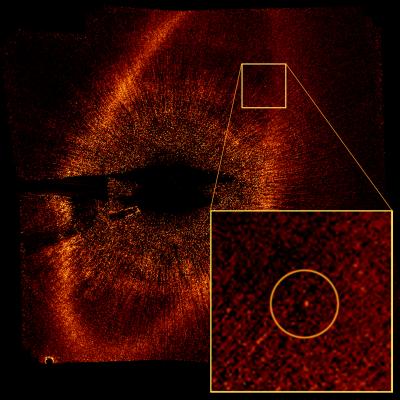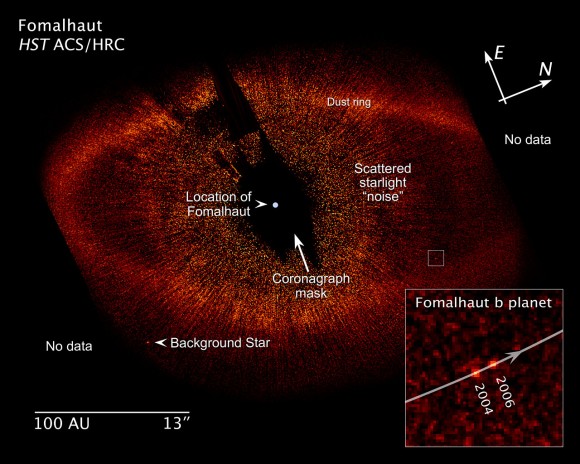Hubble Takes First Visible Light Image of Extrasolar Planet
Written by Nancy Atkinson
Persistence has paid off for astronomer Paul Kalas. After eight years and taking repeated photographs with the Hubble Space Telescope of a nearby star, he finally has what he and many astronomers have been striving for: the first visible-light snapshot of a planet outside our solar system. This coincides with the announcement of the first time astronomers have taken pictures of another multi-planet solar system, using the Gemini and Keck Telescopes. Kalas has been studying the star Fomalhaut, located about 25 light years from Earth, for several years. He knew the planet was there, because its perturbations were evident in the ring of gas and dust surrounding the star. The planet is probably close to the mass of Jupiter, and it orbits Fomalhaut at a distance about four times that between Neptune and the sun. Formally known as Fomalhaut b, the planet could have a ring system about the dimension of Jupiter's early rings, before the dust and debris coalesced into the four Galilean moons. Learn more in the video below…

The planet's existence was suspected in 2005, when images Kalas took with the Hubble Space Telescope's Advanced Camera for Surveys showed a sharply defined inner edge to the dust belt around Fomalhaut, in the southern constellation Piscus Austrinus. The sharp edge and off-center belt suggested to Kalas that a planet in an elliptical orbit around the star was shaping the inner edge of the belt, much like Saturn's moons groom the edges of its rings.
"The gravity of Fomalhaut b is the key reason that the vast dust belt surrounding Fomalhaut is cleanly sculpted into a ring and offset from the star," Kalas said. "We predicted this in 2005, and now we have the direct proof."
Check out this video from ESA about the discovery:
"It will be hard to argue that a Jupiter-mass object orbiting an A star like Fomalhaut is anything other than a planet," said coauthor James R. Graham, professor of astronomy at UC Berkeley. "That doesn't mean it's exactly what we expected when we went hunting for planets in this system."
"Every planet has a chaotic zone, which is basically a swath of space that encloses the planet's orbit and from which the planet ejects all particles," said Eugene Chiang, a UC Berkeley associate professor of astronomy and of earth and planetary science, and first author of the ApJ paper. "This zone increases with the mass of the planet, so, given the size of the chaotic zone around Fomalhaut b, we can estimate that its likely mass is in the vicinity of one Jupiter mass."

Kalas now has two photographs of the planet, taken in 2004 and 2006, which show that its movement over a 21-month period exactly fits what would be expected from a planet orbiting Fomalhaut every 872 years at a distance of 119 astronomical units, or 11 billion miles. One astronomical unit (AU) is the average distance between the Earth and the sun, or 93 million miles.
"I nearly had a heart attack at the end of May when I confirmed that Fomalhaut b orbits its parent star," Kalas said. "It's a profound and overwhelming experience to lay eyes on a planet never before seen."
Hubble Takes First Visible Light Image of Extrasolar Planet | Universe Today

Written by Nancy Atkinson
Persistence has paid off for astronomer Paul Kalas. After eight years and taking repeated photographs with the Hubble Space Telescope of a nearby star, he finally has what he and many astronomers have been striving for: the first visible-light snapshot of a planet outside our solar system. This coincides with the announcement of the first time astronomers have taken pictures of another multi-planet solar system, using the Gemini and Keck Telescopes. Kalas has been studying the star Fomalhaut, located about 25 light years from Earth, for several years. He knew the planet was there, because its perturbations were evident in the ring of gas and dust surrounding the star. The planet is probably close to the mass of Jupiter, and it orbits Fomalhaut at a distance about four times that between Neptune and the sun. Formally known as Fomalhaut b, the planet could have a ring system about the dimension of Jupiter's early rings, before the dust and debris coalesced into the four Galilean moons. Learn more in the video below…

The planet's existence was suspected in 2005, when images Kalas took with the Hubble Space Telescope's Advanced Camera for Surveys showed a sharply defined inner edge to the dust belt around Fomalhaut, in the southern constellation Piscus Austrinus. The sharp edge and off-center belt suggested to Kalas that a planet in an elliptical orbit around the star was shaping the inner edge of the belt, much like Saturn's moons groom the edges of its rings.
"The gravity of Fomalhaut b is the key reason that the vast dust belt surrounding Fomalhaut is cleanly sculpted into a ring and offset from the star," Kalas said. "We predicted this in 2005, and now we have the direct proof."
Check out this video from ESA about the discovery:
"It will be hard to argue that a Jupiter-mass object orbiting an A star like Fomalhaut is anything other than a planet," said coauthor James R. Graham, professor of astronomy at UC Berkeley. "That doesn't mean it's exactly what we expected when we went hunting for planets in this system."
"Every planet has a chaotic zone, which is basically a swath of space that encloses the planet's orbit and from which the planet ejects all particles," said Eugene Chiang, a UC Berkeley associate professor of astronomy and of earth and planetary science, and first author of the ApJ paper. "This zone increases with the mass of the planet, so, given the size of the chaotic zone around Fomalhaut b, we can estimate that its likely mass is in the vicinity of one Jupiter mass."

Kalas now has two photographs of the planet, taken in 2004 and 2006, which show that its movement over a 21-month period exactly fits what would be expected from a planet orbiting Fomalhaut every 872 years at a distance of 119 astronomical units, or 11 billion miles. One astronomical unit (AU) is the average distance between the Earth and the sun, or 93 million miles.
"I nearly had a heart attack at the end of May when I confirmed that Fomalhaut b orbits its parent star," Kalas said. "It's a profound and overwhelming experience to lay eyes on a planet never before seen."
Hubble Takes First Visible Light Image of Extrasolar Planet | Universe Today



 Please Scroll Down to See Forums Below
Please Scroll Down to See Forums Below 












